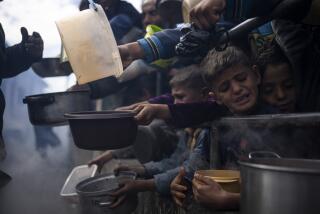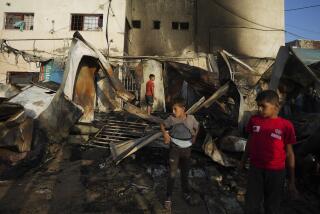Along With Bombs, U.S. Drops Rations
- Share via
WASHINGTON — They are canary yellow and emblazoned with the American flag. A typical one contains beans in tomato sauce, biscuits, jam, peanut butter and potatoes in vinaigrette--but no meat and no alcohol. They cost $4.25 each and total 2,200 calories.
Those sealed plastic packages, called “humanitarian daily rations,” or HDRs, rained down on Afghanistan from U.S. Air Force cargo planes Sunday night.
About 37,500 were in the first airdrop, which the U.S. government acknowledges will be only a stopgap measure in a country with an estimated 5.5 million internal refugees. The supplies dropped by two C-17 cargo planes would help fewer than one in 100, and only for a single day.
But the food packages, developed during conflicts in the Balkans to meet the dietary restrictions of Muslims, are an important political tool--a way for President Bush to send the message that the United States’ quarrel is not with the Afghan people but with the Taliban leaders who harbor Osama bin Laden.
Each package carried the words, in English, French and Spanish: “This is a food gift from the people of the United States of America.”
“As we strike military targets, we will also drop food, medicine and supplies to the starving and suffering men and women and children of Afghanistan,” Bush told the nation Sunday.
Military officials tried to avoid past mistakes that made their food drops lethal to some recipients. The HDRs pack only half the calories of military ready-to-eat meals out of concern over harming starving people by overloading their digestive systems.
And airdrops of years past have sometimes posed physical dangers to those rushing to collect them. At least a dozen Kurd refugees were killed by falling food in the early 1990s as they ran to catch much-needed supplies.
In Sudan, loose water bottles fell from heights that turned them into tiny missiles, and even cargo attached to parachutes hit the ground so hard that contents were destroyed.
The method likely to be used over Afghanistan has been practiced in Italy in recent years. In an operation that aid workers call a “flutter drop,” tethered boxes filled with two-pound packages of daily rations are pushed out of planes flying above the range of antiaircraft artillery.
The airdrops aren’t risk-free to the deliverers either. In Afghanistan, the Taliban is believed to have antiaircraft weapons that might be used against slow-moving cargo planes, especially at the low altitudes most effective for drops of food and medical supplies.
The decision to make the food drops was welcomed by humanitarian aid workers, who hope it indicates Bush’s commitment to safeguard efforts to feed millions threatened with starvation in drought-ridden Afghanistan.
Until the U.S. strikes Sunday, aid groups had been moving supplies into the country over land--almost all of it from neighboring Pakistan, albeit with far more difficulty.
“The situation has gotten more challenging,” said Mark Bartolini, vice president of governmental relations for the nonprofit International Rescue Committee.
Bartolini said relief agencies have been working to shore up existing networks of Afghan drivers as well as private merchants who have their own security forces. Even donkeys and other pack animals have been acquired to reach remote areas, he said.
But Bartolini said the aid community--like the military--saw airlifts as capable of handling only a small fraction of the need. Before Sept. 11, famine-relief workers had decided to nearly double food deliveries to Afghanistan to handle a flood of people heading to the borders because of famine. The decision increased to 50,000 metric tons from 30,000 metric tons the food already being trucked into the landlocked country each month. A metric ton is 2,200 pounds--about the same weight as a compact car.
The C-17--the planes used Sunday to drop rations--can hold up to 170,900 pounds of cargo.
Defense Secretary Donald H. Rumsfeld and Gen. Richard B. Myers, chairman of the Joint Chiefs of Staff, declined to talk specifically about how and where the drops were being made.
” . . . We’re targeting remote locations where it’s difficult to get trucks in,” Meyers said.
The yellow pouches contain sketches depicting people eating the contents.
“The universal language of pictures,” said Pentagon spokesman Army Lt. Col. George Rhynedance.
More to Read
Sign up for Essential California
The most important California stories and recommendations in your inbox every morning.
You may occasionally receive promotional content from the Los Angeles Times.











